Structural insights into the voltage and phospholipid activation of the mammalian TPC1 channel
- PMID: 29562233
- PMCID: PMC5886804
- DOI: 10.1038/nature26139
Structural insights into the voltage and phospholipid activation of the mammalian TPC1 channel
Abstract
The organellar two-pore channel (TPC) functions as a homodimer, in which each subunit contains two homologous Shaker-like six-transmembrane (6-TM)-domain repeats. TPCs belong to the voltage-gated ion channel superfamily and are ubiquitously expressed in animals and plants. Mammalian TPC1 and TPC2 are localized at the endolysosomal membrane, and have critical roles in regulating the physiological functions of these acidic organelles. Here we present electron cryo-microscopy structures of mouse TPC1 (MmTPC1)-a voltage-dependent, phosphatidylinositol 3,5-bisphosphate (PtdIns(3,5)P2)-activated Na+-selective channel-in both the apo closed state and ligand-bound open state. Combined with functional analysis, these structures provide comprehensive structural insights into the selectivity and gating mechanisms of mammalian TPC channels. The channel has a coin-slot-shaped ion pathway in the filter that defines the selectivity of mammalian TPCs. Only the voltage-sensing domain from the second 6-TM domain confers voltage dependence on MmTPC1. Endolysosome-specific PtdIns(3,5)P2 binds to the first 6-TM domain and activates the channel under conditions of depolarizing membrane potential. Structural comparisons between the apo and PtdIns(3,5)P2-bound structures show the interplay between voltage and ligand in channel activation. These MmTPC1 structures reveal lipid binding and regulation in a 6-TM voltage-gated channel, which is of interest in light of the emerging recognition of the importance of phosphoinositide regulation of ion channels.
Conflict of interest statement
The authors declare no competing financial interests.
Figures
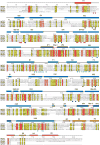
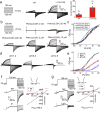
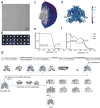
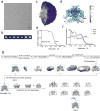

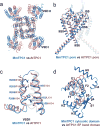

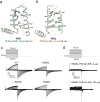

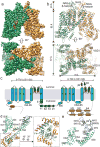




Comment in
-
Two-pore channels open up.Nature. 2018 Apr 5;556(7699):38-40. doi: 10.1038/d41586-018-02783-8. Nature. 2018. PMID: 29620760 No abstract available.
Similar articles
-
Structural mechanisms of phospholipid activation of the human TPC2 channel.Elife. 2019 Mar 12;8:e45222. doi: 10.7554/eLife.45222. Elife. 2019. PMID: 30860481 Free PMC article.
-
Structure and Function of Plant and Mammalian TPC Channels.Handb Exp Pharmacol. 2023;278:155-180. doi: 10.1007/164_2022_599. Handb Exp Pharmacol. 2023. PMID: 35879575
-
Structure of the voltage-gated two-pore channel TPC1 from Arabidopsis thaliana.Nature. 2016 Mar 10;531(7593):196-201. doi: 10.1038/nature16446. Epub 2015 Dec 21. Nature. 2016. PMID: 26689363 Free PMC article.
-
TPC1 vacuole SV channel gains further shape - voltage priming of calcium-dependent gating.Trends Plant Sci. 2023 Jun;28(6):673-684. doi: 10.1016/j.tplants.2023.01.001. Epub 2023 Feb 4. Trends Plant Sci. 2023. PMID: 36740491 Review.
-
Emerging issues of connexin channels: biophysics fills the gap.Q Rev Biophys. 2001 Aug;34(3):325-472. doi: 10.1017/s0033583501003705. Q Rev Biophys. 2001. PMID: 11838236 Review.
Cited by
-
Diversity of two-pore channels and the accessory NAADP receptors in intracellular Ca2+ signaling.Cell Calcium. 2022 Jun;104:102594. doi: 10.1016/j.ceca.2022.102594. Epub 2022 May 5. Cell Calcium. 2022. PMID: 35561646 Free PMC article. Review.
-
NAADP-binding proteins find their identity.Trends Biochem Sci. 2022 Mar;47(3):235-249. doi: 10.1016/j.tibs.2021.10.008. Epub 2021 Nov 20. Trends Biochem Sci. 2022. PMID: 34810081 Free PMC article. Review.
-
Structural basis of ClC-3 transporter inhibition by TMEM9 and PtdIns(3,5)P2.Nat Struct Mol Biol. 2025 Jul 16. doi: 10.1038/s41594-025-01617-2. Online ahead of print. Nat Struct Mol Biol. 2025. PMID: 40670814
-
Lysosomal solute and water transport.J Cell Biol. 2022 Nov 7;221(11):e202109133. doi: 10.1083/jcb.202109133. Epub 2022 Oct 11. J Cell Biol. 2022. PMID: 36219209 Free PMC article. Review.
-
Structural basis for activation of voltage sensor domains in an ion channel TPC1.Proc Natl Acad Sci U S A. 2018 Sep 25;115(39):E9095-E9104. doi: 10.1073/pnas.1805651115. Epub 2018 Sep 6. Proc Natl Acad Sci U S A. 2018. PMID: 30190435 Free PMC article.
References
-
- Furuichi T, Cunningham KW, Muto S. A putative two pore channel AtTPC1 mediates Ca(2+) flux in Arabidopsis leaf cells. Plant Cell Physiol. 2001;42:900–905. - PubMed
Publication types
MeSH terms
Substances
Grants and funding
LinkOut - more resources
Full Text Sources
Other Literature Sources
Molecular Biology Databases

